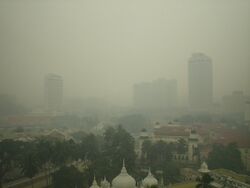Contrast-to-noise ratio
From HandWiki
Short description: Measure of determine image quality

Contrast-to-noise ratio (CNR)[1] is a measure used to determine image quality. CNR is similar to the metric signal-to-noise ratio (SNR), but subtracts a term before taking the ratio. This is important when there is a significant bias in an image, such as from haze.[2] As can be seen in the picture at right, the intensity is rather high even though the features of the image are washed out by the haze. Thus this image may have a high SNR metric, but will have a low CNR metric.
One way to define contrast-to-noise ratio is:[3][4]
where SA and SB are signal intensities for signal producing structures A and B in the region of interest and σo is the standard deviation of the pure image noise.
See also
References
- ↑ Welvaert, Marijke; Rosseel, Yves; Yacoub, Essa (6 November 2013). "On the Definition of Signal-To-Noise Ratio and Contrast-To-Noise Ratio for fMRI Data". PLOS ONE 8 (11): e77089. doi:10.1371/journal.pone.0077089. PMID 24223118. Bibcode: 2013PLoSO...877089W.
- ↑ Jiang, Hou; Lu, Ning; Yao, Ling (14 October 2016). "A High-Fidelity Haze Removal Method Based on HOT for Visible Remote Sensing Images". Remote Sensing 8 (10): 844. doi:10.3390/rs8100844. Bibcode: 2016RemS....8..844J.
- ↑ Desai, Nikunj. "Practical Evaluation of Image Quality in Computed Radiographic (CR) Imaging Systems". http://www.moderntech.com.hk/sites/default/files/whitepaper/V06_Manuscript_0.pdf.
- ↑ Timischl, F. (January 2015). "The contrast-to-noise ratio for image quality evaluation in scanning electron microscopy". Scanning 37 (1): 54–62. doi:10.1002/sca.21179. PMID 25533747.
 |

